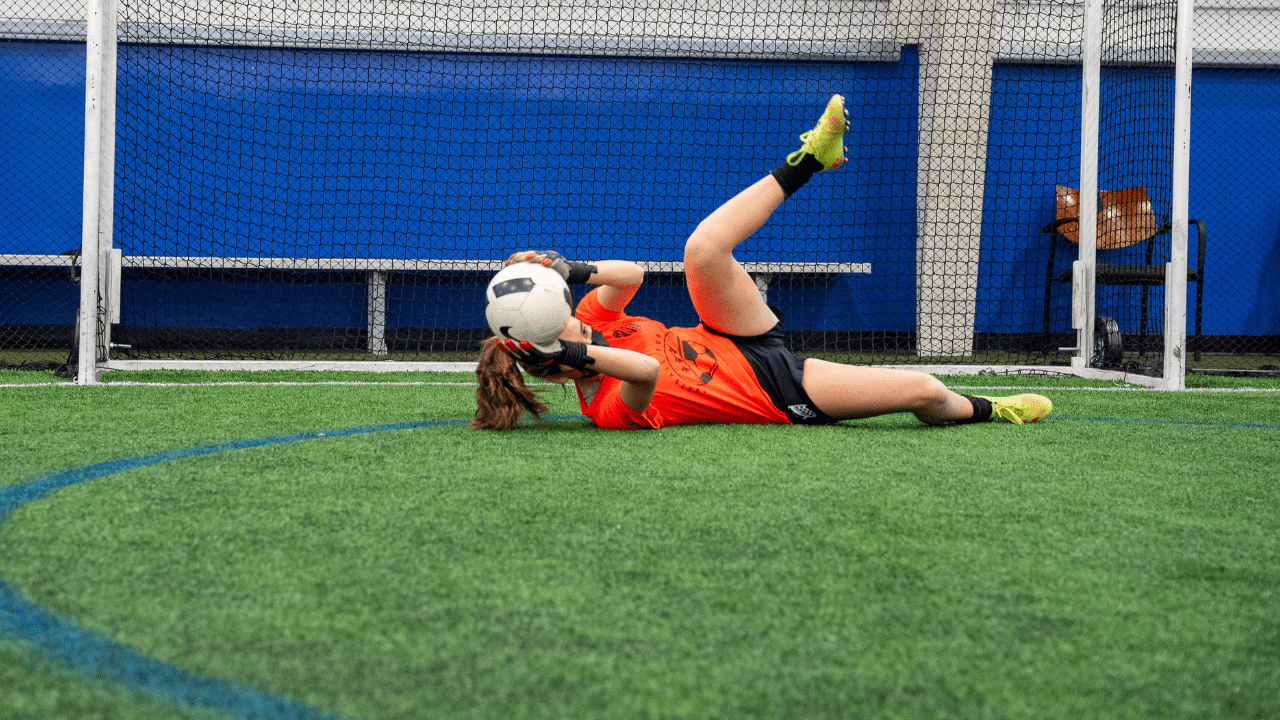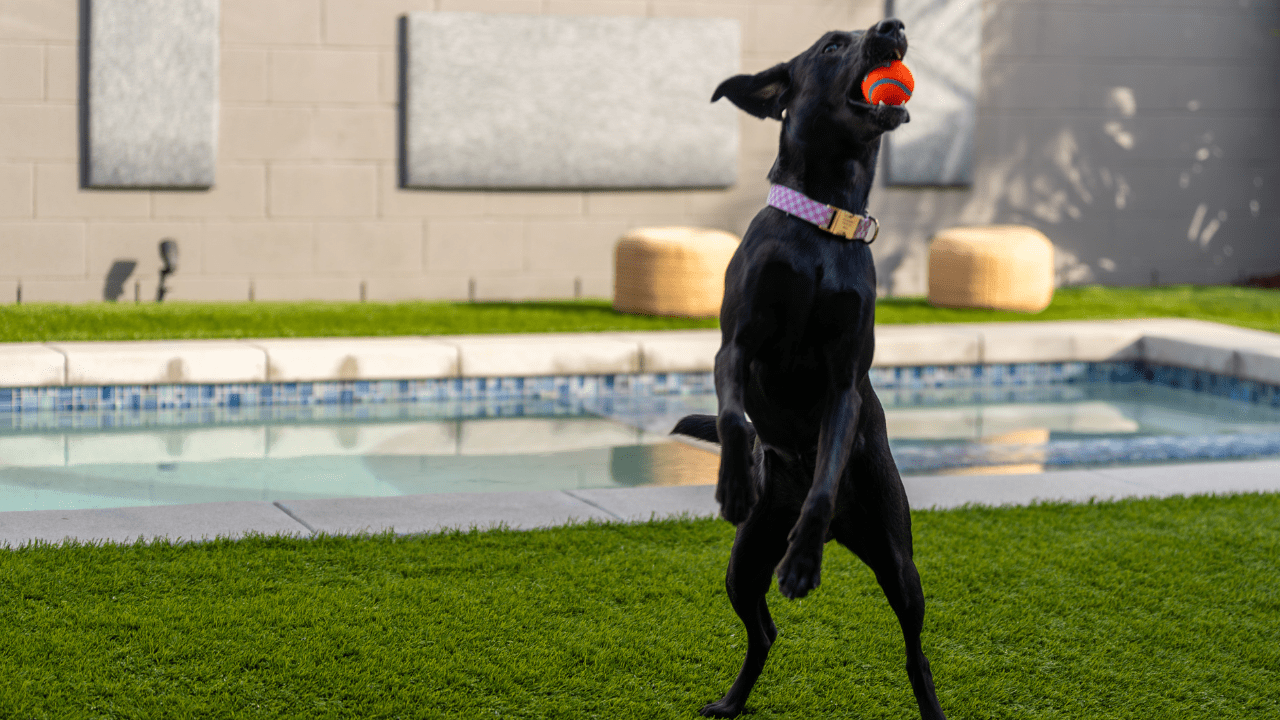It is 100% possible and beneficial to upgrade high-traffic areas with artificial ground cover. This is true if you’re a lawn-owner who cares mostly about foot-feel and living experience. It’s true if you’re looking for a budget-friendly outdoor landscaping option. It’s even true if you’re more of a “protect the planet” type who’s looking for eco-friendly solutions. And all of this is ESPECIALLY true for high-traffic spaces. That’s a lot to ask of turf, but stick with me, folks. This stuff has come a long way in the last few decades. It’ll surprise you (just like it did me).
Today’s blog helps you understand synthetic turf and its advantages. You’ll learn how to choose the right ground cover for your space and how to install it. And you’ll even get some tips and suggestions on protecting your investment by making it more beautiful and useful, as well as caring for your artificial ground cover.
Why is Artificial Ground Cover Great for High-Traffic Spaces?
-
- Artificial ground cover is a durable, low-maintenance alternative to natural grass for high-traffic areas
- It comes in various styles, colors and textures to mimic natural grass or other ground covers
- Installing artificial ground cover can improve aesthetics and functionality while reducing maintenance
Understanding Artificial Ground Cover
Walk before you run, right? So, let’s talk artificial ground cover basics. These are synthetic materials used to enhance and protect high-traffic areas. Think parks, backyards, playgrounds, sports fields, and commercial spaces. Don’t get me wrong. I like natural grass. But artificial turf has some strong benefits. I love its durability, low upkeep, and resistance to wear and tear. But it’s more than that. These days you can get artificial turf in a lot of different of styles, colors and textures. You can find options that look and feel like grass and other natural ground covers.
When I was a kid, artificial turf was only used at big, expensive sports arenas. And frankly, I didn’t like it. It was stiff. It didn’t really soften the concrete underneath it. And I’m fairly certain nature never produced that shade of green … ever. Skip a few decades ahead. I was skeptical when I heard people were using it for their lawns and park spaces. No thanks, I’m not interested in getting rug burns in my yard. But here I am, folks, eating my words. I’ve seen it at my kids’ local playground. I’ve seen it installed at some homes, too. The grass was lush and soft. It held up amazingly well to dozens of energetic kids running around all day. No mud, no bare patches, no problem!
Today’s artificial turf is worth a deeper look. And you can definitely upgrade high-traffic areas with artificial ground cover.
Advantages of Using Artificial Ground Cover in High-Traffic Areas
-
- Durability – can handle heavy foot traffic day in and day out without getting torn up or worn down
- Low maintenance – no mowing, watering, weeding or chemicals needed, just occasional rinsing and brushing
- Stays green and pristine year-round, even in harsh climates or shady areas
One huge advantage? Its toughness. Artificial ground cover can handle heavy foot traffic day in and day out without getting torn up or worn down. I’ve maintained natural lawns for decades. Natural grass often turns to dirt and mud in busy areas. Synthetic grass stays green and pristine. It’s great for lawns with families and pets. It’s definitely ideal for places like dog parks, playgrounds, and sports fields that see a lot of action.
And artificial turf is way easier than regular grass to maintain. No mowing. No watering or weeding. And there’s no need for any chemical treatments. Just give it an occasional rinse and brushing to keep it looking spiffy. This low-maintenance aspect is a huge plus for schools, businesses, and homeowners who don’t want to spend tons of time and money on upkeep.
Selecting the Right Type of Artificial Ground Cover
With so many artificial grass options out there, how do you pick the right one for your needs? Consider factors like the amount of foot traffic the area gets, the desired look and feel, and your budget.
For high-traffic spots, choose a turf with durable, short blades that can withstand heavy use. If you want a lusher look, go for longer blades in a multi-color blend. And don’t forget about infill – those tiny granules that help keep the grass blades perky. For a truly convincing appearance, choose an infill that mimics natural soil.
Preparing the Area for Installation
Proper site preparation is key for a long-lasting artificial grass installation. First, excavate the area to a depth of 3-4 inches and level it out. Then, lay down a weed barrier to prevent any pesky plants from poking through your pristine turf.
Next, add a layer of crushed stone for drainage and stability. Compact it well with a tamper or roller. Finally, top it off with a layer of decomposed granite or sand to create a smooth base for the turf A little extra prep work goes a long way in preventing lumps, bumps, and dips in your finished product.
Installing Artificial Ground Cover on Various Surfaces
We have a full article about installing artificial grass. But here are some important highlights.
Artificial grass is incredibly versatile and can be installed on all kinds of surfaces, from concrete to soil. For concrete, make sure to repair any cracks or damage first. Then, simply lay the turf on top and secure it with adhesive or nails around the edges.
If you’re installing over soil, follow the site prep steps above to create a stable base. Then, roll out your turf and trim it to fit the space. Secure the edges with landscape staples or nails every few inches. For a polished look, use seaming tape and adhesive to join any turf sections together seamlessly.
Maintenance and Cleaning Tips for Artificial Ground Cover
-
- Weekly:
– Rinse with hose to remove dust and debris
– Use mild detergent and scrub brush for stubborn stains
- Weekly:
-
- Monthly:
– Brush with stiff broom or power brush to fluff up blades and prevent matting
– Top up infill as needed to keep blades standing tall
– Avoid harsh chemicals that could damage fibers
- Monthly:
Artificial grass is low-maintenance, not no-maintenance. Keeping it looking lush and perky is pretty easy. Give it a weekly rinse with a hose to remove dust and debris. And when you run across more stubborn stains, use a mild detergent and scrub brush. Harsh chemicals could damage the fibers. My advice: just avoid’em.
Every month or so, give your turf a good brushing with a stiff broom or power brush to fluff up the blades and prevent matting. This will help maintain that fresh, just-installed look. And don’t forget to top up the infill as needed to keep the blades standing tall.
Enhancing the Aesthetics of High-Traffic Areas
Artificial ground cover does more than just provide a durable surface – it can totally transform the look of a space. Use it to add pops of green to concrete jungles or create eye-catching designs with different colors and textures.
Get creative with your installation by mixing artificial grass with other materials like pavers, rocks, or mulch. Create meandering pathways, cozy seating nooks, or whimsical play areas. The possibilities are endless! With artificial turf, you can bring the beauty of nature to even the harshest urban environments.
Common Concerns and Misconceptions About Artificial Ground Cover
One of the biggest misconceptions about artificial grass is that it looks fake and tacky. I touched on this above. And it’s worth saying again. Modern turf products are incredibly realistic. Varied blade heights, colors, and textures mimic natural grass. From a distance, it’s often hard to tell the difference!
Another concern is heat retention. While artificial grass can get hot in direct sunlight, there are ways to mitigate this. Choose a turf with built-in cooling technology or install it in a shaded area. You can also opt for a lighter color that reflects more sunlight.
Comparing Artificial Ground Cover to Natural Grass
So, how does artificial turf stack up against natural grass? In terms of maintenance, artificial grass wins hands down. No mowing, watering, or fertilizing required. It also stays green and lush year-round, even in harsh climates or shady areas where grass struggles to grow.
That’s not to say natural grass doesn’t have some serious benefits, too. Especially for local ecologies. It helps with storm-water management. It reduces air pollution and provides a natural habitat for insects and small animals. And if initial investment is your main concern, artificial turf costs more upfront. Though its reduced maintenance expenses generally recover those upfront costs.
Cost Analysis and Return on Investment
-
- Artificial grass installation cost: $5-$20 per square foot, including installation
- Natural grass sod installation cost: $0.14 to $0.60 per square foot
- Requires ongoing maintenance costs for water, fertilizer, mowing
- Over 10-year period, artificial grass can be more cost-effective
- Especially in areas with high water prices or strict water restrictions
- Can boost property value and curb appeal
Speaking of cost, let’s break it down. Artificial grass typically runs $5-$20 per square foot, including installation. Natural grass sod is cheaper at first, around $0.14 to $0.60 per square foot, but requires ongoing maintenance costs for water, fertilizer, and mowing.
Over a 10-year period, artificial grass can actually be more cost-effective, especially in areas with high water prices or strict water restrictions. Plus, it can boost property value and curb appeal. Many home buyers appreciate the low-maintenance aspect of artificial turf.
The Bottom Line on Artificial Ground Cover
That was a lot of ground to cover (sorry, I couldn’t resist). Now you can answer to our original question of “can I upgrade high-traffic areas with artificial ground cover”. But let’s be honest, there’s always more you can learn about a subject. This is no exception. So if all this turf talk has created some more questions for you, Artificial Turf Supply has a whole team of experienced experts who would love to chat with you. Just give them a call at (866) 677-9405. Or feel free to explore the website some more. There’s a lot of good blogs and informative pages to help you make your decision.
But if you’re ready to know how much your unique lawn project will cost, let’s create a quote!





